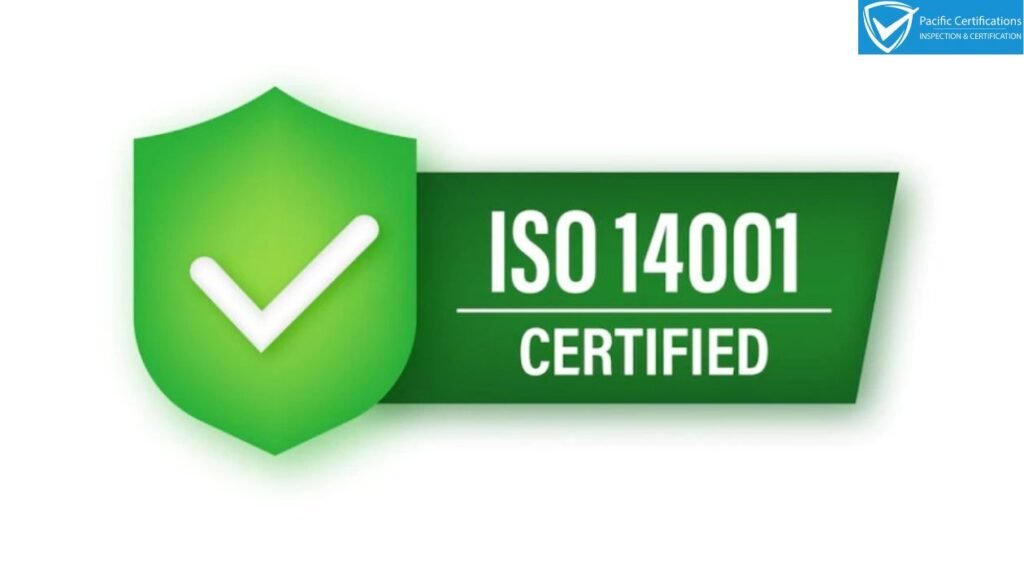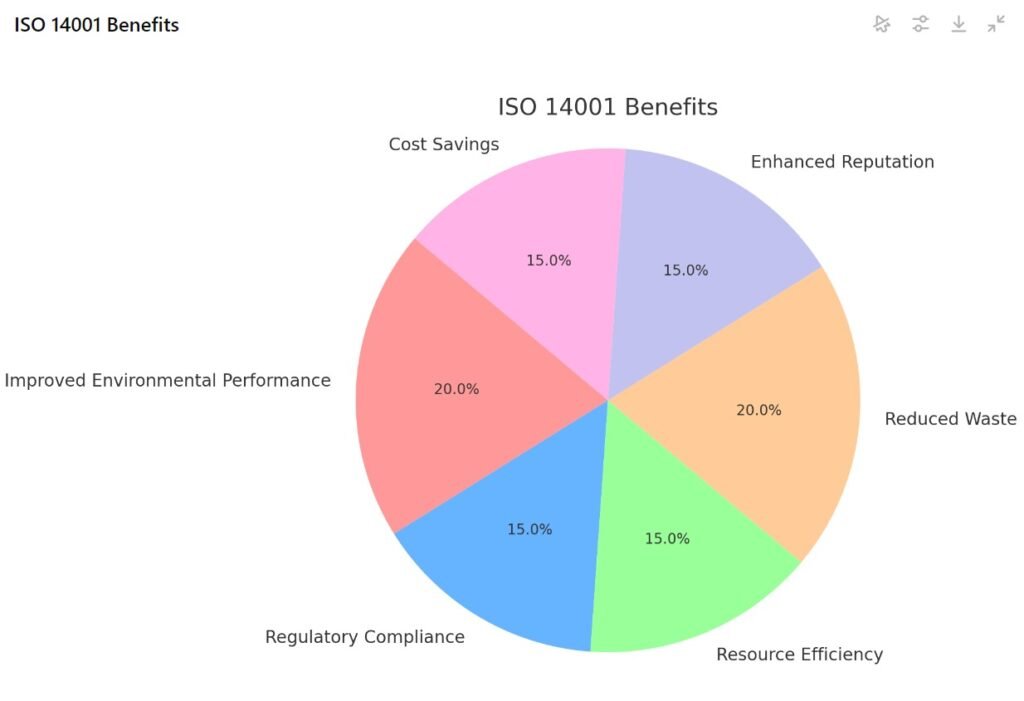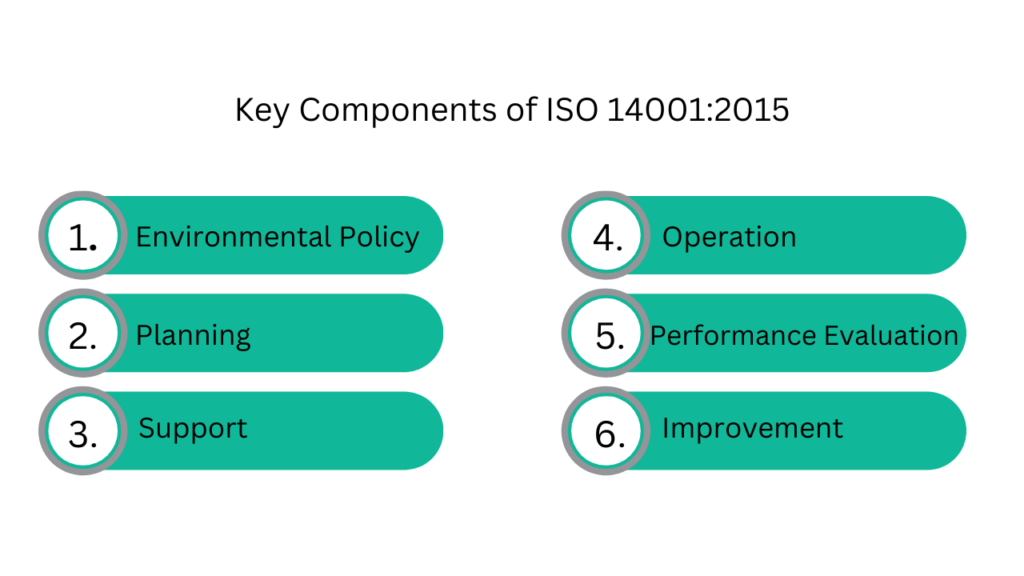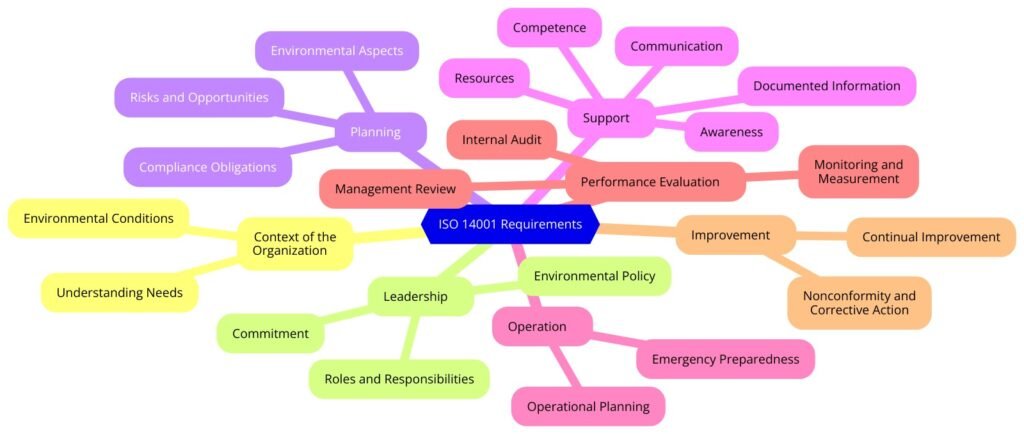
What is ISO 14001:2015 Environmental Management Systems?
ISO 14001:2015 is an international standard that specifies the requirements for an effective Environmental Management System (EMS). It provides a framework that an organization can follow, rather than establishing environmental performance requirements. The standard is applicable to any organization, regardless of size, type, and nature, and it applies to the environmental aspects of its activities, products, and services that the organization determines it can either control or influence, considering a life cycle perspective.
What are the Key Elements of ISO 14001:2015
- Context of the Organization
- Leadership
- Planning
- Support
- Operation
- Performance Evaluation
- Improvement
Structure of ISO 14001:2015- Clause wise
Clause 1: Scope
This clause defines the scope of the standard, specifying the requirements for an EMS that an organization can use to enhance its environmental performance. It applies to any organization, regardless of size, type, and nature, and applies to the environmental aspects it can control or influence.
Clause 2: Normative References
This clause provides references to other documents that are indispensable for the application of ISO 14001:2015. As of its publication, there are no normative references.
Clause 3: Terms and Definitions
This clause lists the terms and definitions that apply to ISO 14001:2015, ensuring a common understanding of key concepts.
Clause 4: Context of the Organization
- 4.1 Understanding the Organization and Its Context: Identifying internal and external issues relevant to the EMS.
- 4.2 Understanding the Needs and Expectations of Interested Parties: Determining the needs and expectations of stakeholders.
- 4.3 Determining the Scope of the EMS: Defining the boundaries and applicability of the EMS.
- 4.4 Environmental Management System: Establishing, implementing, maintaining, and continually improving the EMS.
Clause 5: Leadership
- 5.1 Leadership and Commitment: Top management’s role in demonstrating leadership and commitment to the EMS.
- 5.2 Environmental Policy: Developing and maintaining an environmental policy that supports environmental protection and the context of the organization.
- 5.3 Organizational Roles, Responsibilities, and Authorities: Assigning roles and ensuring resources are available for the EMS.
Clause 6: Planning
- 6.1 Actions to Address Risks and Opportunities: Identifying and addressing risks and opportunities related to environmental aspects, compliance obligations, and other factors.
- 6.1.1 General
- 6.1.2 Environmental Aspects: Identifying environmental aspects and determining those that have or can have significant impacts.
- 6.1.3 Compliance Obligations: Identifying and ensuring compliance with legal and other requirements.
- 6.1.4 Planning Action: Planning actions to address significant environmental aspects, compliance obligations, and risks and opportunities.
- 6.2 Environmental Objectives and Planning to Achieve Them: Setting environmental objectives and planning how to achieve them.
- 6.2.1 Environmental Objectives
- 6.2.2 Planning Actions to Achieve Environmental Objectives
Clause 7: Support
- 7.1 Resources: Determining and providing necessary resources for the EMS.
- 7.2 Competence: Ensuring that persons doing work under the organization’s control are competent.
- 7.3 Awareness: Ensuring that persons doing work under the organization’s control are aware of the EMS.
- 7.4 Communication: Ensuring effective internal and external communication related to the EMS.
- 7.4.1 General
- 7.4.2 Internal Communication
- 7.4.3 External Communication
- 7.5 Documented Information: Creating and controlling documented information.
- 7.5.1 General
- 7.5.2 Creating and Updating
- 7.5.3 Control of Documented Information
Clause 8: Operation
- 8.1 Operational Planning and Control: Planning, implementing, and controlling processes to meet EMS requirements.
- 8.2 Emergency Preparedness and Response: Preparing for and responding to potential emergency situations.
Clause 9: Performance Evaluation
- 9.1 Monitoring, Measurement, Analysis, and Evaluation: Monitoring and measuring EMS performance.
- 9.1.1 General
- 9.1.2 Evaluation of Compliance
- 9.2 Internal Audit: Conducting internal audits to ensure the EMS is effective.
- 9.2.1 General
- 9.2.2 Internal Audit Program
- 9.3 Management Review: Top management’s periodic review of the EMS.
Clause 10: Improvement
- 10.1 General: Identifying opportunities for improvement.
- 10.2 Nonconformity and Corrective Action: Managing nonconformities and taking corrective actions.
- 10.3 Continual Improvement: Continually improving the suitability, adequacy, and effectiveness of the EMS.
Pacific Certifications is accredited by ABIS, if you need support with ISO 14001 certification for your business, please contact us at support@pacificcert.com or +91-8595603096.
Benefits of ISO 14001 Environmental Management System Certifications

ISO 14001:2015 is an internationally recognized standard for Environmental Management Systems. It provides a framework for organizations to manage and mitigate their environmental impacts.
Below are the common benefits:
- ISO 14001 helps organizations systematically identify and manage environmental aspects and impacts, leading to improved environmental performance.
- ISO 14001 ensures that an organization stays compliant with relevant environmental laws and regulations.
- Certification demonstrates a commitment to environmental responsibility, which can enhance an organization’s reputation among customers, investors, and other stakeholders.
- By implementing systematic approaches to resource management and waste reduction, organizations can achieve significant cost savings.
- ISO 14001 helps identify potential environmental risks and develop strategies to mitigate them.
- An EMS encourages environmental awareness and responsibility among employees.
- Certification provides assurance to stakeholders, including clients, suppliers, regulators, and the community, that the organization is committed to environmental stewardship.
- As ISO 14001 is an internationally accepted standard, certification allows organizations to operate on a global scale with a recognized environmental management system, facilitating international trade and partnerships.
- ISO 14001 promotes the Plan-Do-Check-Act (PDCA) cycle, organizations are encouraged to regularly review and improve their environmental performance and EMS.
- Adopting ISO 14001 aligns an organization’s operations with sustainable practices.
- Customers are increasingly aware of environmental issues and prefer to do business with companies that demonstrate a commitment to sustainability.
Implementing ISO 14001 can significantly benefit organizations by improving environmental performance, ensuring regulatory compliance, enhancing reputation, and achieving cost savings. It provides a structured approach to managing environmental responsibilities, contributing to overall sustainability and long-term success.
What are the Key Components of ISO 14001:2015

ISO 14001:2015 outlines specific requirements and components essential for the effective establishment and maintenance of an Environmental Management System (EMS). These components ensure that organizations systematically manage their environmental responsibilities and continuously improve their environmental performance. The key components of ISO 14001 are:
- Environmental Policy
- Planning
- 2.1. Environmental Aspects
- 2.2. Compliance Obligations
- 2.3. Risks and Opportunities
- 2.4. Environmental Objectives and Planning to Achieve Them
- Support
- 3.1. Resources
- 3.2. Competence
- 3.3. Awareness
- 3.4. Communication
- 3.5. Documented Information
- Operation
- 4.1. Operational Planning and Control
- 4.2. Emergency Preparedness and Response
- Performance Evaluation
- 5.1. Monitoring, Measurement, Analysis, and Evaluation
- 5.2. Internal Audit
- 5.3. Management Review
- Improvement
- 6.1. Nonconformity and Corrective Action
- 6.2. Continual Improvement
What are the Principles of ISO 14001:2015
ISO 14001:2015 is based on several key principles that guide the effective implementation and operation of an Environmental Management System (EMS). These principles ensure that the EMS is systematic, proactive, and focused on continual improvement. Here are the primary principles of ISO 14001:
- Commitment and Policy
- Planning
- Leadership
- Employee Involvement
- Process Approach
- Continual Improvement
- Evidence-Based Decision Making
- Relationship Management
- Risk-Based Thinking
- Legal and Other Requirements
- Transparency and Accountability
Clause-wise Audit Checklist for ISO 14001:2015
Clause 4: Context of the Organization
4.1 Understanding the Organization and Its Context
- Have the internal and external issues that are relevant to the organization’s purpose and that affect its ability to achieve the intended outcomes of its environmental management system been determined?
- Are these issues documented and reviewed regularly?
4.2 Understanding the Needs and Expectations of Interested Parties
- Has the organization determined the interested parties that are relevant to the environmental management system?
- Are the needs and expectations of these interested parties documented and reviewed?
4.3 Determining the Scope of the Environmental Management System
- Is the scope of the environmental management system clearly defined and documented?
- Does the scope consider the external and internal issues, requirements of interested parties, and the organization’s activities, products, and services?
4.4 Environmental Management System
- Is an environmental management system established, implemented, maintained, and continually improved?
- Does it include the processes needed and their interactions?
Clause 5: Leadership
5.1 Leadership and Commitment
- Are top management demonstrating leadership and commitment to the environmental management system?
- Are responsibilities and authorities for relevant roles assigned and communicated within the organization?
5.2 Environmental Policy
- Has an environmental policy been established, implemented, and maintained?
- Is the policy appropriate to the purpose and context of the organization?
- Is it available to interested parties?
5.3 Organizational Roles, Responsibilities, and Authorities
- Are the roles, responsibilities, and authorities defined, documented, and communicated?
- Is there a management representative responsible for the environmental management system?
Clause 6: Planning
6.1 Actions to Address Risks and Opportunities
- Have risks and opportunities been determined that need to be addressed to achieve the intended outcomes of the environmental management system?
- Are actions planned to address these risks and opportunities?
6.1.2 Environmental Aspects
- Are the environmental aspects and associated impacts identified and documented?
- Are significant environmental aspects determined?
6.1.3 Compliance Obligations
- Are compliance obligations determined and documented?
- Are they reviewed regularly?
6.1.4 Planning Action
- Are actions to address significant environmental aspects, compliance obligations, and risks and opportunities planned and integrated into the environmental management system?
6.2 Environmental Objectives and Planning to Achieve Them
- Are environmental objectives established, documented, and maintained?
- Are plans to achieve these objectives developed, including responsibilities, resources, timeframes, and evaluation methods?
Clause 7: Support
7.1 Resources
- Are resources determined and provided to establish, implement, maintain, and improve the environmental management system?
7.2 Competence
- Are competencies needed for the effective performance of the environmental management system determined?
- Are actions taken to acquire necessary competencies?
7.3 Awareness
- Are persons working under the organization’s control aware of the environmental policy, significant environmental aspects, and their impacts, and their roles in the environmental management system?
7.4 Communication
- Are internal and external communication processes regarding the environmental management system established?
- Is relevant information communicated consistently?
7.5 Documented Information
- Is documented information required by the environmental management system determined, controlled, and maintained?
- Are documents available, suitable, and protected?
Clause 8: Operation
8.1 Operational Planning and Control
- Are processes needed to meet the requirements of the environmental management system established and controlled?
- Are controls to prevent deviation from environmental policy and objectives in place?
8.2 Emergency Preparedness and Response
- Are potential emergency situations identified?
- Are procedures for emergency preparedness and response established, implemented, and tested?
Clause 9: Performance Evaluation
9.1 Monitoring, Measurement, Analysis, and Evaluation
- Are methods for monitoring, measurement, analysis, and evaluation established?
- Is environmental performance evaluated and documented?
9.1.2 Evaluation of Compliance
- Are compliance obligations evaluated regularly?
- Are necessary actions taken to address any non-compliance?
9.2 Internal Audit
- Are internal audits conducted at planned intervals?
- Is the internal audit process documented and effectively implemented?
9.3 Management Review
- Are management reviews conducted at planned intervals?
- Do management reviews include assessing opportunities for improvement and changes in external and internal issues?
Clause 10: Improvement
10.1 General
- Are opportunities for improvement identified and implemented?
- Is continual improvement of the environmental management system ensured?
10.2 Nonconformity and Corrective Action
- Are nonconformities addressed promptly?
- Are corrective actions implemented to control and correct nonconformities and to prevent recurrence?
10.3 Continual Improvement
- Are processes for continual improvement of the environmental management system established and maintained?
Plan-Do-Check-Act (PDCA) Explained- ISO 14001:2015
The Plan-Do-Check-Act (PDCA) cycle is a four-step management method used for the control and continuous improvement of processes and products. In the context of ISO 14001:2015, the PDCA cycle provides a framework for organizations to achieve continual improvement of their environmental management system.
Here is a detailed explanation of each phase of the PDCA cycle within ISO 14001:
Plan
Establish Objectives and Processes
- Context of the Organization (Clause 4): Determine the internal and external issues that affect the EMS, understand the needs and expectations of interested parties, and define the scope of the EMS.
- Leadership (Clause 5): Establish the environmental policy and ensure leadership commitment. Define roles, responsibilities, and authorities.
- Planning (Clause 6): Identify environmental aspects and impacts, determine compliance obligations, assess risks and opportunities, and establish environmental objectives. Develop plans to achieve these objectives, including resource allocation and setting performance criteria.
Do
Implement the Plan
- Support (Clause 7): Provide the necessary resources, ensure competence and awareness among employees, and establish communication processes. Maintain documented information to support the EMS.
- Operation (Clause 8): Implement the operational controls to manage significant environmental aspects, compliance obligations, and risks. Establish emergency preparedness and response procedures to address potential emergency situations.
Check
Monitor and Measure Processes
- Performance Evaluation (Clause 9): Monitor and measure the key characteristics of operations that can have significant environmental impacts. Evaluate compliance with legal and other requirements. Conduct internal audits to ensure the EMS is being implemented as planned. Management reviews should assess the EMS’s performance and effectiveness, considering changes in external and internal issues.
Act
Take Action to Improve Performance
- Improvement (Clause 10): Address nonconformities by taking corrective actions to prevent their recurrence. Use the results of the performance evaluation and management reviews to identify opportunities for improvement. Implement continual improvement processes to enhance the EMS’s overall performance.
Application of PDCA in ISO 14001:2015 Clauses
Plan
Context of the Organization (Clause 4):
- Identify internal and external issues that can affect the intended outcomes of the EMS.
- Understand the needs and expectations of interested parties.
- Determine the scope of the EMS considering the identified issues and needs.
- Establish an EMS that includes the processes needed to meet the standard’s requirements.
Leadership (Clause 5):
- Ensure top management demonstrates leadership and commitment.
- Develop an environmental policy that is appropriate to the organization’s context.
- Assign roles, responsibilities, and authorities for the EMS.
Planning (Clause 6):
- Identify environmental aspects and impacts associated with the organization’s activities.
- Determine compliance obligations (legal and other requirements).
- Identify risks and opportunities related to environmental aspects and compliance obligations.
- Establish environmental objectives and plans to achieve them, including setting performance criteria and resource allocation.
Do
Support (Clause 7):
- Provide necessary resources for establishing, implementing, maintaining, and improving the EMS.
- Ensure that personnel are competent and aware of their roles and responsibilities.
- Establish communication processes for internal and external stakeholders.
- Maintain documented information required by the EMS.
Operation (Clause 8):
- Implement processes to manage significant environmental aspects, compliance obligations, and risks.
- Establish and maintain operational controls.
- Develop and implement emergency preparedness and response procedures.
Check
Performance Evaluation (Clause 9):
- Monitor and measure the key characteristics of operations that can have significant environmental impacts.
- Evaluate the organization’s compliance with legal and other requirements.
- Conduct internal audits to ensure the EMS conforms to planned arrangements and is effectively implemented.
- Perform management reviews to evaluate the EMS’s performance, considering changes in external and internal issues.
Act
Improvement (Clause 10):
- Address nonconformities and take corrective actions to prevent their recurrence.
- Use the results of performance evaluation and management reviews to identify opportunities for improvement.
- Implement continual improvement processes to enhance the overall performance of the EMS.
If you need support with ISO 14001 certification for your business, please contact us at support@pacificcert.com or +91-8595603096.
ISO 14001 Certification Requirements: Implementing ISO 14001:2015

Implementing ISO 14001:2015 involves meeting a set of requirements that guide organizations in establishing an effective Environmental Management System. This standard is designed to help organizations improve their environmental performance, reduce environmental impact, and ensure compliance with relevant legal and other requirements. Here are the key requirements and steps to implement ISO 14001:
Understanding the Organization and Its Context
- Context of the Organization (Clause 4.1): Identify external and internal issues that can affect the EMS. This includes understanding the environmental conditions that affect or are affected by the organization.
- Needs and Expectations of Interested Parties (Clause 4.2): Determine the relevant interested parties and their needs and expectations.
Leadership
- Leadership and Commitment (Clause 5.1): Top management must demonstrate leadership and commitment to the EMS.
- Environmental Policy (Clause 5.2): Establish an environmental policy that is appropriate to the organization, provides a framework for setting environmental objectives, and includes commitments to environmental protection, compliance obligations, and continual improvement.
- Organizational Roles, Responsibilities, and Authorities (Clause 5.3): Assign roles and responsibilities for EMS-related activities.
Planning
- Actions to Address Risks and Opportunities (Clause 6.1): Determine risks and opportunities that need to be addressed to achieve intended outcomes, prevent or reduce undesired effects, and achieve continual improvement.
- Environmental Aspects (Clause 6.1.2): Identify environmental aspects of activities, products, and services that can control or influence, and determine those that have or can have significant environmental impacts.
- Compliance Obligations (Clause 6.1.3): Identify and have access to compliance obligations related to environmental aspects.
- Environmental Objectives and Planning to Achieve Them (Clause 6.2): Establish environmental objectives at relevant functions and levels, and plan actions to achieve these objectives.
Support
- Resources (Clause 7.1): Determine and provide the resources needed for the establishment, implementation, maintenance, and continual improvement of the EMS.
- Competence (Clause 7.2): Ensure that persons doing work under the organization’s control are competent based on education, training, or experience.
- Awareness (Clause 7.3): Ensure persons are aware of the environmental policy, significant environmental aspects, and their contributions to the effectiveness of the EMS.
- Communication (Clause 7.4): Establish, implement, and maintain the processes needed for internal and external communication.
- Documented Information (Clause 7.5): Maintain documented information required by the standard and necessary for the effectiveness of the EMS.
Operation
- Operational Planning and Control (Clause 8.1): Plan, implement, and control the processes needed to meet EMS requirements and to implement the actions identified in planning.
- Emergency Preparedness and Response (Clause 8.2): Establish, implement, and maintain processes needed to prepare for and respond to potential emergency situations.
Performance Evaluation
- Monitoring, Measurement, Analysis, and Evaluation (Clause 9.1): Monitor, measure, analyze, and evaluate environmental performance and the effectiveness of the EMS.
- Internal Audit (Clause 9.2): Conduct internal audits at planned intervals to provide information on whether the EMS conforms to the organization’s requirements and the ISO 14001 standard.
- Management Review (Clause 9.3): Top management must review the organization’s EMS at planned intervals to ensure its continuing suitability, adequacy, and effectiveness.
Improvement
- Nonconformity and Corrective Action (Clause 10.2): React to nonconformities and take action to control and correct them.
- Continual Improvement (Clause 10.3): Continually improve the suitability, adequacy, and effectiveness of the EMS.
Steps to Implement ISO 14001:2015 to Certification
Achieving ISO 14001:2015 certification involves a series of steps that ensure your organization has implemented an effective EMS in accordance with the standard’s requirements. Here’s a comprehensive guide to the process:
- Gap Analysis
- Project Planning
- Training and Awareness
- Documentation
- Implementation
- Internal Audit
- Management Review
- Certification Audit
Commitment and Initial Planning
- Top Management Commitment: Secure commitment from top management to provide the necessary resources and support for the EMS.
Initial Planning:
- Conduct a gap analysis to compare your current environmental management practices with ISO 14001:2015 requirements.
- Develop a project plan with clear objectives, timelines, and responsibilities.
Define Context and Scope
Understanding the Organization and Its Context (Clause 4.1):
- Identify external and internal issues that can affect the EMS.
- Determine the relevant interested parties and their requirements (Clause 4.2).
Scope of the EMS (Clause 4.3): Define the boundaries and applicability of the EMS
Develop an Environmental Policy (Clause 5.2): Establish an environmental policy that aligns with your organization’s context and commitments to environmental protection, compliance obligations, and continual improvement.
Planning (Clause 6)
- Environmental Aspects (Clause 6.1.2): Identify environmental aspects and evaluate their significance.
- Compliance Obligations (Clause 6.1.3): Identify and access applicable legal and other requirements.
- Risk and Opportunities (Clause 6.1.1): Determine risks and opportunities related to the EMS.
- Environmental Objectives (Clause 6.2): Establish measurable environmental objectives and plans to achieve them.
Support (Clause 7)
- Resources (Clause 7.1): Allocate necessary resources for EMS implementation.
- Competence (Clause 7.2): Ensure personnel are competent based on education, training, or experience.
- Awareness (Clause 7.3): Ensure employees are aware of the EMS policy, significant environmental aspects, and their contributions.
- Communication (Clause 7.4): Establish processes for internal and external communication regarding the EMS.
- Documented Information (Clause 7.5): Maintain documented information required by the standard and for the effectiveness of the EMS.
Operation (Clause 8)
- Operational Planning and Control (Clause 8.1): Plan and control operations related to significant environmental aspects.
- Emergency Preparedness and Response (Clause 8.2): Establish procedures for responding to emergency situations.
Performance Evaluation (Clause 9)
- Monitoring, Measurement, Analysis, and Evaluation (Clause 9.1): Monitor and measure key characteristics of operations that can have significant environmental impact.
- Internal Audit (Clause 9.2): Conduct internal audits at planned intervals to ensure compliance and identify areas for improvement.
- Management Review (Clause 9.3): Top management should review the EMS periodically to ensure its suitability, adequacy, and effectiveness.
Improvement (Clause 10)
- Nonconformity and Corrective Action (Clause 10.2): Address nonconformities by taking corrective actions.
- Continual Improvement (Clause 10.3): Continually improve the EMS to enhance environmental performance.
Certification Process
- Select a Certification Body: Choose an accredited certification body to conduct the external audit.
- Stage 1 Audit: The certification body reviews your EMS documentation and readiness for the Stage 2 audit.
- Stage 2 Audit: The certification body conducts a comprehensive audit to verify the implementation and effectiveness of your EMS.
Achieve Certification
- Certification Decision: If the certification body finds your EMS compliant with ISO 14001:2015, they will issue the certification.
Maintaining Certification
- Surveillance Audits: Undergo periodic surveillance audits by the certification body to ensure continued compliance.
- Continual Improvement: Continuously monitor, measure, and improve your EMS to maintain certification and enhance environmental performance.
Contact us today if you need support with ISO 14001 certification for your business, at suppport@pacificcert.com or +91-8595603096.
Suggested Certifications –









